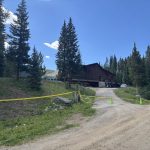Top 5 most-read stories last week: Breckenridge tourism, migration to Colorado and new mountain bike trail

Kit Geary/Summit Daily News
Stories in this list received the most page views on SummitDaily.com from Aug. 10-16.
1. In this resort community, people are resorting to living out of cars. Unsheltered in Summit reports near-record usage and a need for year-round lot.
A Summit County nonprofit that provides a safe parking space for those living out of their cars had a waitlist around 20 people long at the height of winter 2024-25.
Born out of a housing crisis, Unsheltered in Summit started out serving six to eight people a year when it began in 2019. Today, the organization serves around 65 people a year. President Diane Luellen said the nonprofit needs visibility now more than ever.
Unsheltered in Summit held one of its first-ever information sessions outside the Summit County Library in Frisco on Wednesday, Aug. 6, to kick off the initiative.
A few factors fuel Unsheltered in Summit’s visibility efforts.
Unsheltered in Summit helps people who found themselves without housing due to unforeseen circumstances or those willingly live out of their cars knowing they can’t afford housing. Luellen’s work with the Summit Colorado Interfaith Council helped her get acquainted with Raychel Kelly, who founded Good Bridge Community, the predecessor to Unsheltered in Summit, in 2019. In the six years since, she still sees a need to address the stigma around the program’s users.
She finds some people make an assumption and tie the program’s users to problems like mental health instead of the actual problem at hand: a lack of attainable housing in the area that locals can afford.
“Because it is so hard not only to afford housing in Summit County, but to find housing in Summit County and keep it, these folks have simply chosen this way of putting a roof over their head, and they are taxpaying citizens … This is the way that they have found that has enabled them to stay in Summit,” she said.
Aside from Kelly, another catalyst of Unsheltered in Summit is Paul Minjares. Minjares is a longtime Summit resident who made the switch to living out of his vehicle after seeing an approximate $700 rent hike in the room he lived in from 2012 to 2021. Minjare’s story is shared by dozens of others in the program.
— Kit Geary
2. ‘The reality is — down is down:’ Breckenridge Tourism Office, elected officials hone in on drop in summer tourism
Unfavorable tourism data trends prompted the Breckenridge Tourism Office to consider summer 2025 an “anomaly,” so much so the office doesn’t plan to use it as a base comparison for future years.
Breckenridge Tourism Office president Lucy Kay said the office can’t identify why summer visitation stats have dropped at an Aug. 12 Breckenridge Town Council meeting. Prior reports from the Breckenridge Tourism Office indicated summer overnight visitation was down around 14-15%. She said not knowing the reason behind a dip in tourism is unusual, and July is looking particularly down based on preliminary data. Data indicated lodging numbers were down around 12% on July 4.
She said July currently has the office’s “undivided attention” as it contemplates if changes need to occur for next year.
Kay said, at face value, the drop may appear significant, especially considering Breckenridge is behind its competitive destination set, but noted the town is in a unique position. She said 2021 brought unsustainable tourism volumes to Breckenridge, and it continued to have strong visitation compared to much of its competitive set, which includes towns such as Park City and Steamboat Springs, in the following years.
“They’re coming up from a lower position, we’re coming down from a higher position,” she said, explaining still Breckenridge has more booked nights than its competitive set — it just doesn’t have more nights booked than it did last year.
Breckenridge Tourism Office director of operations Bill Wishowski used Park City’s data, which is considered perhaps the most comparable destination to Breckenridge because it has a similar number of available lodging rooms, to demonstrate Kay’s point. He said where Park City had around 75,600 nights booked as of Aug. 3, Breckenridge had around 109,000 nights booked.
“It’s not so bad in the macro sense, but the reality is — down is down,” Kay said.
— Kit Geary
3. Fewer people are moving to Colorado in 2025 — but some Western Slope counties are bucking the trend
New data shows Colorado’s allure for newcomers is weakening, with net migration down more than 50% since 2015. Some counties on the Western Slope are defying the trend, however, drawing more families and workers to its mountains.
Net migration to Colorado declined by 52% from 2015 to 2025, reflecting roughly 36,000 fewer individual arrivals this year, according to a July migration report by the Common Sense Institute, a conservative-backed nonprofit research organization.
The decline for the Denver Metro area is even higher — around 69.6% relative to 2015, which is a notable drop when compared to the net migration of other metro areas in states like Utah, Texas, Washington and Florida, which all saw a positive change in net migration.
Some parts of the Western Slope, however, show promising indicators or healthier growth, according to the August report.
“Colorado is a very expensive state to live in. We are aging very rapidly, and we’re having fewer birth rates. Our economy is showing signs of slumping in the future,” said report author and Director of Research Caitlin McKennie. “But while this is true, we are seeing areas such as the Western Slope that are really thriving in terms of attracting movers to these locations and having families.”
Garfield and Mesa counties are among the few regions expected to “buck the trend.” According to McKennie, factors like relative affordability, economic opportunity and quality of life in these counties appear to be driving higher-than-historic projections of net migration in the near future.
It’s important to note that “2025 was a very high year for net migration,” according to McKennie. The year 2015 was selected as a baseline for the research in order to track the change in migration within the 10 years, she said.
Additionally, the decrease in working-age adults to the state is not contrary to what other parts of the country have seen as states continue to recover from the pandemic and adapt to new economic policies.
— Andrea Teres-Martinez
4. New mountain bike flow trail promises thrills for bikers at Frisco Peninsula
The Frisco Peninsula Recreation Area continues to expand its vast network of mountain biking, hiking and running trails.
Nearly two years after completing the high-speed jump trail — Aftermath — Summit County’s McGill Trails LLC has spent the summer steadily working to open a new directional flow trail on the Frisco Peninsula.
Named Wildhack, the new trail will be approximately one-half mile long and will be a downhill-only mountain bike trail.
According to McGill Trails LLC co-founder Tyler Mitchell, McGill approached Frisco Nordic Center and Trail Manager Pete Swenson at the beginning of the summer season to see if he had any work for the trail building company to complete.
Not only did Swenson want McGill to complete maintenance work on Aftermath throughout the summer season, but the group of experienced trail builders were also asked to construct a new, downhill mountain bike trail.
Upon arriving at the proposed trail site located on the backside of the Frisco Peninsula Recreation Area, McGill Trails LLC was able to get an idea of what Swenson envisioned the trail looking like.
“It was cool to see the flags they had put out there and the direction they wanted to go,” Swenson said. “We kind of came in and put our own little twist on things. It was really awesome because they kind of let us be free and trusted us to throw our flavor on it.”
On June 24, McGill officially broke ground on the trail and has been working regularly in the area ever since. Unlike Aftermath, which is targeted towards experienced downhill mountain bikers who can maneuver around large berms and jumps, Wildhack will serve as an approachable trail for mainly intermediate riders.
“The idea was to have something a little bit more approachable for younger and beginner-type riders, but also still be fun for those intermediate and advanced riders,” Mitchell said. “It is kind of really a hard concept to create because you are trying to make a broad spectrum of riders happy.”
— Cody Jones
5. Now the 5th largest wildfire in Colorado history, the Lee Fire grows to more than 110,000 acres as ‘extreme fire behavior’ expected to continue
Firefighters made progress toward containing one of the largest wildfires in Colorado history over the weekend, but officials said “extreme fire weather” is expected to continue Monday and throughout the week.
The Lee Fire had burned 113,378 acres in Rio Blanco County — an area that is larger than Denver County — as of Monday, according to the complex incident management team responding to the fire. That makes the wildfire the fifth largest in Colorado history.
After heading into the weekend with no containment, fire officials said the Lee Fire is now 7% contained. But on Monday, the firefighters responding to the fire encountered flame lengths over 100 feet and rates of spread greater than 1 mph, according to a morning update posted to InciWeb.Wildfire.gov.
“Key factors of extreme fire behavior are present and as a result, large fire growth is being observed on the Lee Fire,” the complex incident management team wrote. “Fire behavior is being driven by weather and critically low live and dead fuel moistures.”
Fire officials said the town of Meeker, power, oil and gas infrastructure that are “critical to the local rural economy and natural gas supply” and private structures along Colorado Highways 13 and 16 and County Roads 5 and 13 were among the areas of concern Monday.
Evacuations and pre-evacuation orders remain in place in the area, with the Rio Blanco County Sheriff’s Office in a Facebook post Monday morning updating the evacuation status for certain zones to “ready” and “set.”
“The likelihood for fire to impact values is high,” fire officials said. “Resistance to control will also be high.”
Burning further east in Rio Blanco County, the Elk Fire had scorched 14,635 acres as of Monday morning, according to InciWeb. Containment on that blaze now stands at 30%, with firefighters making progress through the weekend. On Monday, officials said firefighters will continue to increase containment on the south end of the fire perimeter along County Road 8.
Garfield County public schools on Monday announced that the two wildfires burning not far from the county’s borders will delay the start to the school year due to interruptions to communication and poor air quality. School district officials cancelled school Monday and Tuesday with the goal of opening schools Wednesday.
On Saturday, the Colorado Department of Corrections safely evacuated the Rifle Correctional Center in response to the Lee Fire, with officials citing an “abundance of caution to ensure the safety of all individuals involved.”
With temperatures in the upper 70s to low 80s, Monday may be the coolest day of the upcoming week and could trend warmer each day until at least Wednesday, according to the incident management team. Gusty winds and dry conditions are also expected to continue this week.
As of Monday, there were 1,088 personnel responding to the Lee and Elk fires, according to the official Elk and Lee Fire Information Facebook page. That includes 12 aircraft, 24 hand crews and 60 engines.
— Ryan Spencer

Support Local Journalism

Support Local Journalism
As a Summit Daily News reader, you make our work possible.
Summit Daily is embarking on a multiyear project to digitize its archives going back to 1989 and make them available to the public in partnership with the Colorado Historic Newspapers Collection. The full project is expected to cost about $165,000. All donations made in 2023 will go directly toward this project.
Every contribution, no matter the size, will make a difference.










